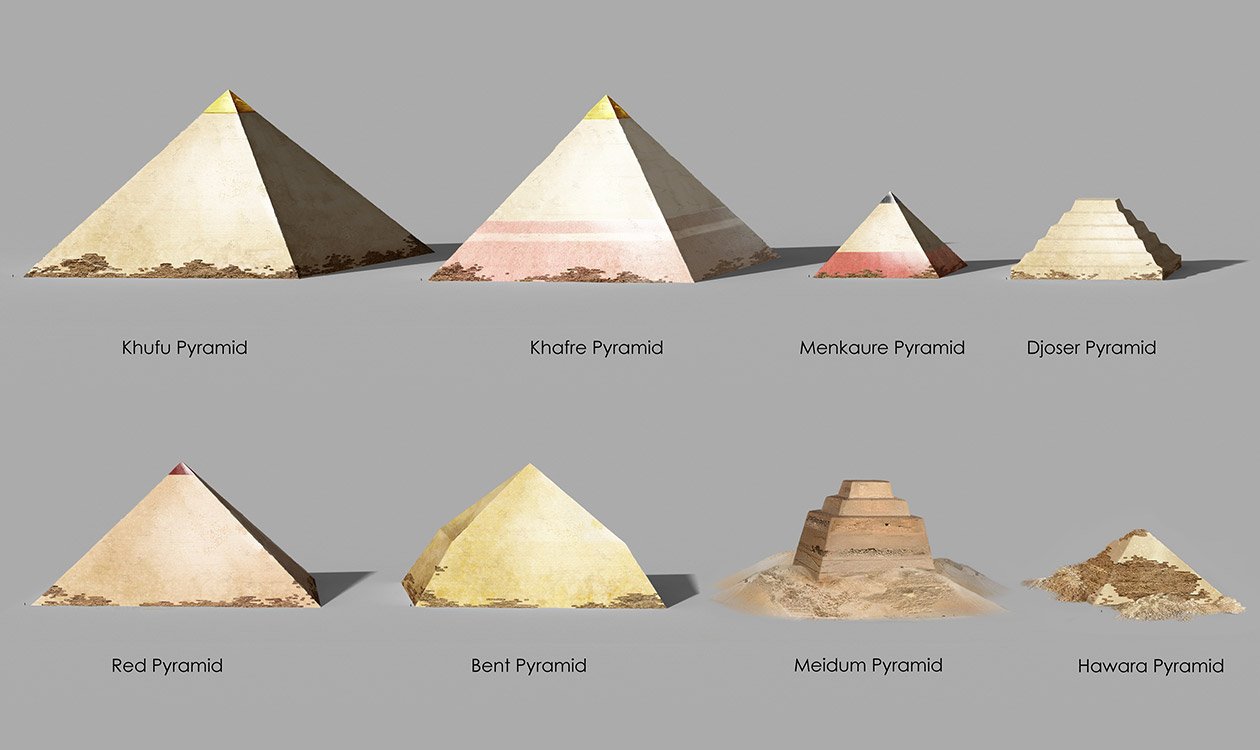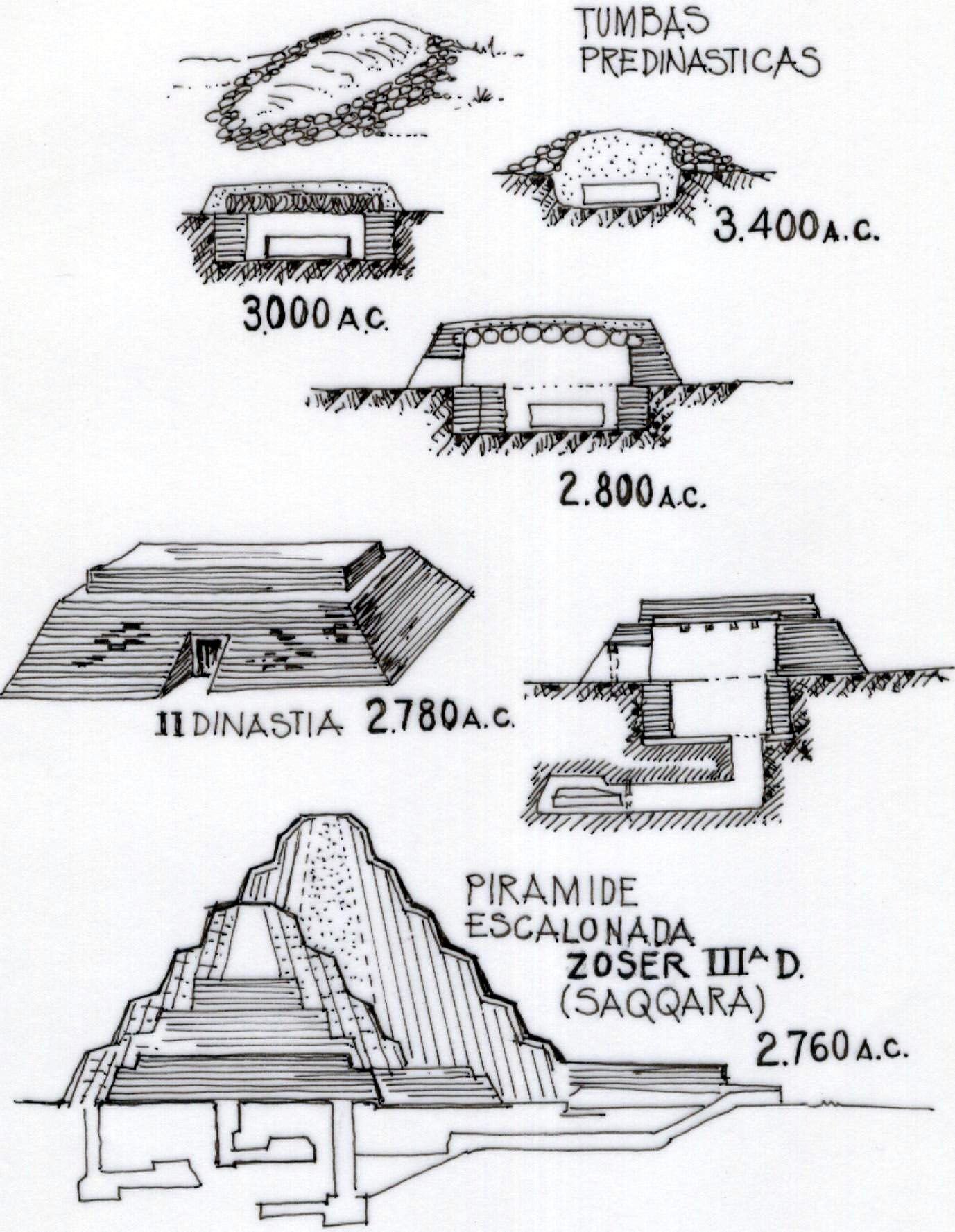The Evolution Of Egyptian Pyramid Structures: From Mastabas To The Great Pyramid Of Khufu

Egyptian Pyramids size comparison concept art from The Art of Assassin’s Creed: Origins book
The Egyptian pyramids are among the most iconic and enduring symbols of ancient civilization. Over the centuries, these monumental structures have captivated the imagination of millions, inspiring both awe and curiosity. The development of pyramid structures in ancient Egypt spanned several centuries and evolved from simple pre-dynastic tombs to the grandiose constructions that we associate with the term “pyramid” today. This article will explore the evolution of Egyptian pyramid structures, beginning with the mastaba tombs of the pre-dynastic period and culminating with the Great Pyramid of Khufu.

I. PRE-DYNASTIC MASTABA TOMBS

Before the construction of the first pyramids, the people of ancient Egypt buried their dead in structures known as mastabas. These flat-roofed, rectangular structures were made of mud-brick and served as tombs for the elite members of society. The word “mastaba” is derived from the Arabic word for “bench,” reflecting the bench-like shape of these structures. Mastabas featured an underground burial chamber accessed through a vertical shaft and a chapel above ground where family members could perform rituals and leave offerings for the deceased.
II. THE STEP PYRAMID OF DJOSER: A MONUMENTAL LEAP
The construction of the first pyramid in Egypt is attributed to Pharaoh Djoser, who ruled during the 3rd Dynasty (circa 2667-2648 BCE). His vizier, Imhotep, is credited as the architect behind the innovative design of the Step Pyramid, which is considered the first large-scale stone monument in the world. The Step Pyramid, located in Saqqara, represented a significant departure from the mastaba tombs that preceded it.

The Step Pyramid consists of six distinct mastaba-like layers, stacked one on top of the other, with each subsequent layer smaller than the one below it. This design gave the structure its distinct stepped appearance. The pyramid was initially intended as a traditional mastaba tomb, but Imhotep expanded the design, transforming it into a revolutionary new architectural concept. The Step Pyramid served as a template for future pyramid construction and marked the beginning of the Old Kingdom era of pyramid building.

III. THE TRANSITION TO TRUE PYRAMIDS: SNEFERU’S INNOVATIONS
During the reign of Pharaoh Sneferu (circa 2613-2589 BCE), the father of Khufu, the design of pyramids underwent further evolution. Sneferu was responsible for the construction of three major pyramids: the Meidum Pyramid, the Bent Pyramid, and the Red Pyramid.
The Meidum Pyramid began as a step pyramid, but was later modified into a true pyramid by filling in the steps with limestone casing stones. However, the structure experienced a catastrophic collapse, likely due to the unstable foundation and steep angle.

Learning from the failure at Meidum, Sneferu’s architects designed the Bent Pyramid, which featured a change in the angle of inclination midway through its construction. This adjustment likely prevented a collapse, but resulted in the pyramid’s unique bent shape.
Sneferu’s final pyramid, the Red Pyramid, is considered the first successful true pyramid. Its smooth sides and consistent angle of inclination set the standard for future pyramid construction, paving the way for the Great Pyramid of Khufu.

IV. THE CULMINATION: THE GREAT PYRAMID OF KHUFU
The pinnacle of pyramid evolution is undoubtedly the Great Pyramid of Khufu (circa 2580-2560 BCE), which remains one of the Seven Wonders of the Ancient World. Located in Giza, the Great Pyramid stands at approximately 481 feet tall and was the tallest man-made structure in the world for nearly 4,000 years. It is constructed from an estimated 2.3 million limestone blocks, some of which weigh over 15 tons. The precision and craftsmanship exhibited in its construction continue to baffle modern engineers and architects.
The Great Pyramid was built as a tomb for Pharaoh Khufu, and its original purpose was to serve as a stairway to the heavens, allowing the pharaoh’s soul to ascend to the afterlife. The pyramid features three burial chambers: the King’s Chamber, the Queen’s Chamber, and an unfinished subterranean chamber. The King’s Chamber contains a granite sarcophagus, presumably for Khufu, but no remains have ever been found inside.

The construction methods used to build the Great Pyramid remain a subject of debate and speculation. It is believed that a large workforce of skilled laborers and engineers was required to complete the pyramid over a 20-year period. Some theories suggest the use of ramps or levers to move and lift the massive stone blocks into place.
V. THE LEGACY OF EGYPTIAN PYRAMID STRUCTURES
The pyramids of Egypt stand as a testament to the architectural and engineering prowess of ancient Egyptian civilization. Although the construction of pyramids declined after the reign of Khufu, their influence is still evident in later structures, such as the Nubian pyramids of Sudan and the Meroe pyramids.
The evolution of pyramid structures, from simple mastaba tombs to the awe-inspiring Great Pyramid of Khufu, represents a fascinating journey through the architectural advancements and cultural beliefs of ancient Egypt. Today, these iconic monuments continue to captivate visitors from around the world, serving as a powerful reminder of humanity’s enduring drive to create, innovate, and leave a lasting legacy.
Related Post
A shocking documentary proves that mermaids do exist
SHOCKING Revelation: Thuya, Mother of Queen Tiye, Was the Grandmother of Akhenaten and Tutankhamun—What Ancient Egyptian Secrets Did She Leave Behind?
Breaking News: Astonishing Discoveries at Karahan Tepe Confirm an Extraterrestrial Civilization is Hiding on Earth, and NO ONE Knows!
Breaking News: Researchers FINALLY Discover U.S. Navy Flight 19 After 75 Years Lost in the Bermuda Triangle!
NASA’s Secret Investigation: Uncovering the Astonishing Mystery of the UFO Crash on the Mountain!
Explosive UFO Docs LEAKED: Startling Proof That Aliens Ruled Ancient Egypt!
